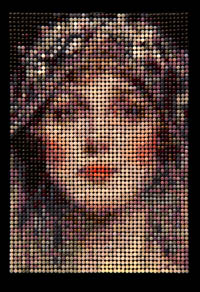



Glass Mosaics
The technique of mosaic was used in the ancient world to illuminate and illustrate, celebrate and commemorate. Gleaming bits of glass embedded in mortar adorned walls, entryways, floors and ceilings. From the gilded expanse of a Ravenna cathedral to the intimacy of a Pompeian portrait, the mosaic tesserae patiently tell their story through and arduous colored glass vocabulary. Veruska Vagen follows this tradition in her work with a technique she calls dot de verre.
|
"Throughout art history artists have studied the work of the masters who came before. Raphael drew from Michelangelo. Van Gogh painted from Rembrandt and Delacroix. Picasso referenced Rubens and Velasquez. The tradition of paying homage through studies of masterpieces served as a tool not only to honor the original work but to become the student of the master as well. In focusing intently on a revered artwork- perhaps choosing a mere segment to study- one becomes intimately involved, even lost within the piece. The journey of revisiting an image perhaps centuries old and with a different material brings new life to a beloved visage or composition and a fresh way of experiencing it. Exchanging paint with tiny glass dots allows the viewer's eye to become the palette. The visual mixing of colors thus embraces Seurat and the Pointillists in addition to the great artists of other eras to whom I pay tribute and from which my pieces are inspired."
| ||
Curator's essay from the Exhibition 'Somewhere in Time' at the Museum of Northwest Art, 2012
"Veruska Vagen updates the centuries-old technique of mosaics with her dot de verre process, and the results are astonishingly beautiful. She also pays tribute to the past with her choice of subject matter: famous and obscure paintings from art history ranging from the 15th to the 20th century.
Vagen explores a variety of paintings from different cultures and time periods, and excerpts from them to create her unique compositions of grids of tiny glass dots. Historical landscapes and portraits of people and animals become contemporary through Vagen's process, and we approach these works with new eyes. From the Cobbe portrait of Shakespeare, 1610, to Van Gogh's Starry Night, 1889, Vagen scans the span of art history for intriguing subjects and her work is made in homage to these past painters.
Originally a painter, Vagen developed her dot de verre (dots of glass) process while working for the William Morris Studio nearly twenty years ago. Having come to Pilchuck Glass School from the southwest, Vagen found in the northwest a community and a technique, both of which have sustained her creative pursuits. Since 1993, Vagen has lived in Stanwood. Her background includes a BFA in Painting with an emphasis in Art History, twelve years as archivist and researcher for glass artist William Morris, and exhibitions throughout the country. Vagen's work is in many private collections, and has received numerous awards.
Her technique distinguishes Vagen from the typical glass artist. Working with 3 millimeter glass dots, she first separates them by color, then arranges them in grids to capture the likenesses of the paintings she is honoring -- an exacting process that takes many hours and requires intense focus. Thousands of dots are used in each piece. Once the image is made, the composition goes into the kiln for two firings, where the dots soften, tack fuse to the backing tile, and fire polish to produce the shimmering images on view. The glass dots are in finite supply, as the factory that produced these forms closed in 1993. Due to the complexity of the material, no attempts have been made to reproduce them.
Somewhere in Time offers a look back and forward, as Veruska Vagen takes us on a historical journey through art and makes her subjects contemporary through her innovative technique, one that she developed before the advent of the computer age. The beauty, veracity, and underlying complexity comes through in the images as well as the process, producing a lasting, compelling body of work that encompasses a rich tradition while breaking new ground."
![]() - Kathleen Moles
- Kathleen Moles
![]() Curator of Exhibitions
Curator of Exhibitions